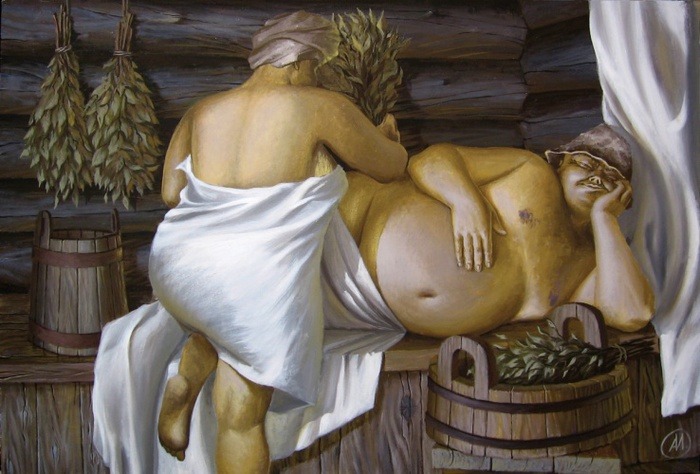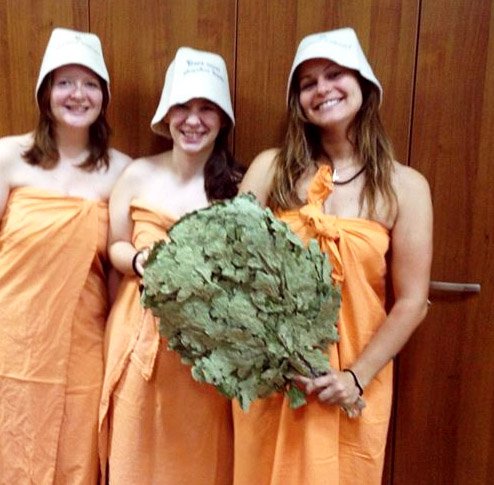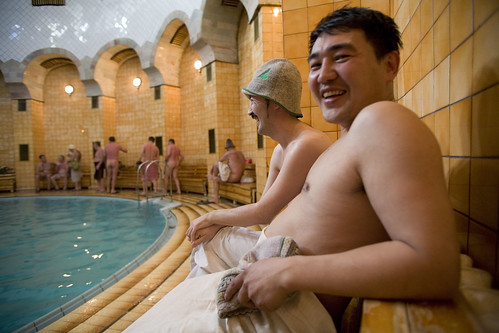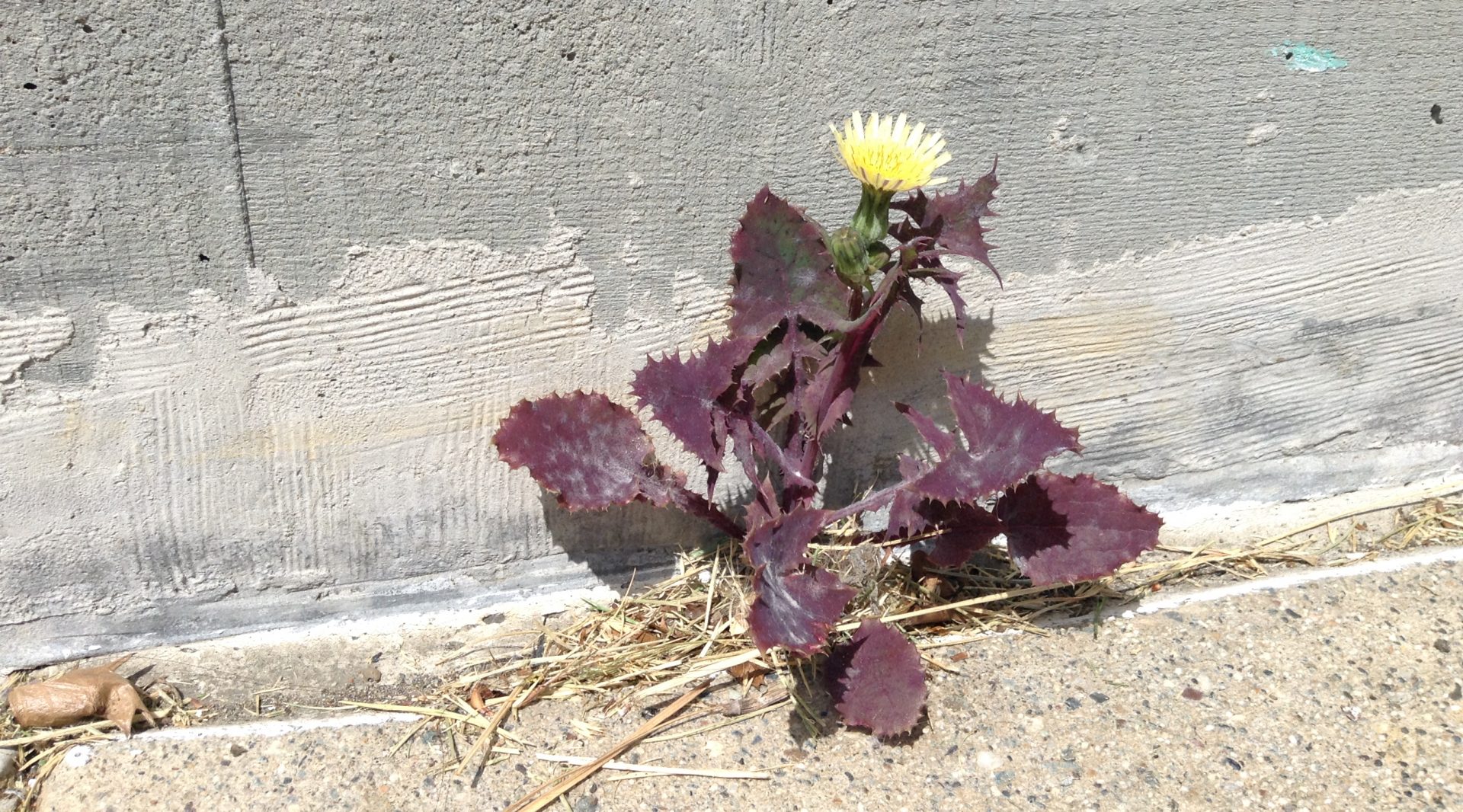March 21st, First Day of Spring
Annie calls at 10am, and I roll over to pick up the phone.
“Banya, at 10:45, you coming?”
“I… maybe,” I say, gravelly-voiced. “Call you back in five.”
I contemplate the possibilities. Sleep in and lounge around having coffee all day, or undertake an awkward naked Russian bathing experience?
Because it’s the spring holiday, I decide on the latter. SMS: I’ll be there.
~~~~
I’ve lived in Kazakhstan for three years, yet this is my first “banya experience,” as the expats say.
Banya is a Russian word that simply means bath. In Mongolia, the town bathhouse was a small building with private shower stalls, because most residents had no shower at home. But more often, the post-Soviet banya is a group experience between same-gender friends or family members. I’ve met a few ardent fans: the colleague who voluntarily hangs out in northern Siberia in the winter (!!), and my bubbly housemate, Zara.
So I walk into Zara’s room and ask if she’ll go with me. She’s on the sofa watching TV and tapping her tablet screen in search of spring fashion photos on Vkontakte, the Russian facebook.
“It’s Friday!” she reprimands me. “Muslims don’t go to the bath on Friday!”
(But when I get there, the banya is full of both Christians and Muslims, Russians and Kazakhs).
An internet search shows me six banyas in Astana, the capital of Kazakhstan. Most have communal steam-rooms and ice-cold baths. Some offer private “VIP” sections for mixed-gender couples, extended families, or—presumably—rich men and their lady friends. The most well-known is Keremet, which means congratulations! It’s located next to the Mega mall, and cost around $7 each for three hours, as of 2014. Below, I’ll describe the experience for any foreigners who might be nervous — I recommend it.
1. Entry Hall of the Keremet Banya
An hour later, I meet three expat friends near the lobby: Annie, Elisa, and Kelsey. We walk inside together, wearing our winter jackets. It’s the spring holidays (Nauruz), which means snow coats the ground outside. There’s a long atrium, and to our left, a girl sells bright lottery tickets. Farther down, a woman offers hot corn-on-the-cob.
“Why?” I whisper to Elisa.
“Guys work out, get hungry,” she shrugs.
On the right, there’s a coat check for our fur and down-filled coats, which we turn in for a numbered token. Coat checks in Astana are free–it’s cold out there!–but the lockers at Keremet are also huge, and you could store a light jacket in the locker room.

By the front entrance, a woman sells birch, pine, and oak venniki (bundled dry branches) for $20 each. We buy dried oak leaves and four felted hats (shapki) for 7000t / $40. Then, we pay the woman at the kassa our admissions fees, 1500t / $7 each for 3 hours in the banya.
Being a post-Soviet sales experience, we buy our tickets from the cashier, then walk to the next table to get them stamped as paid—stamped by a girl who pays no attention to and has no relation to the actual transaction.
2. The Women’s Banya
From the cashier, walk to the back of the atrium, past the fresh juice bar, the shampoo & loofah shop, the manicurist’s salon. The men’s and women’s banyas are separate, with women on the right. Here, another woman guards a desk, takes our tickets and writes them down in a ledger. She asks if we need shower caps and sandals (tapochki), and gives us each a large orange linen, folded. It’s made of starchy material and about 4 foot square.
“Which one of you speaks Russian?” she asks.
“A little,” I nod. She lends sandals for 100t and sells shower caps for 150t. After giving over our stamped tickets, we each get a wrist-band with locker key attached.
As we pass her, we open a door to find women wandering white hallways, draped in orange and white linens. On the left is the locker room, with lockers all tilted in a row. They’re large enough to hold a full coat, bag of swim gear, moderate-sized mammal, or anything else you can imagine.
Other women clusters in the locker-room–banyaing is a communal activity, and friends, family members, or colleagues often go together. It seems easier, though, to go with a group of foreigners, because no one expects us to know what to do. A few older women redirect us, but we’re oblivious enough not to be worried if we do something wrong.
We strip and leave our clothes in the lockers, wrapping ourselves in orange sheets. Large felt hats drape over our eyebrows:

S lygokom parom! my hat reads. “Have a nice bath!”
“The banya steams and gives health,” Elisa’s hat announces. Banya parit, zdorovye darit.
We wave our vennik in the hair at Annie’s phone, and she snaps a picture quickly before putting it away.
3. What is a Banya?
A banya is a Russian bath, but it’s common all over the world. The Romans and Greeks enjoyed meeting friends in communal baths, and first peoples in America had sweat lodges. Even now, steam-houses are called hammams in the Turkish world, saunas in Finland, and banyas in post-Russian areas.
But the banya is more than a bath; it’s also about steam. Vlad Chorazy suggests that Herodotus mentiond early banyas, built by Scythian nomads (early ancestors of the Kazakhs) in felted tents. I guess if you’re moving around every few months for new pasture, you can’t just carry a bathtub on wheels. So instead, they took a tent, piled hot stones in the middle, and poured water over the stones… creating that pleasant, scalding steam-bath effect. All-new energy. All-new skin.
Kelsey and I walk first to the steam room, dim blue and billowing with soaking hot par (steam). We sit on marble benches with our orange togas spread out under us, and chat about vacation plans. Two or three more women join us. Sweat and steam gather and pour down our backs, our arms, our legs. We’re wearing the warm hats (shapki), as the felt is to insulate our heads against the extremes of heat and cold.
We lounge for ten or fifteen minutes. More women join us, and when the steam room is full of people, we go in search of the pool. The banya is a bit of a maze, and it would help to have a guide.
Next, we find the steamy, wet moiniy zal (bath room), where low dividers and benches give access to hot and cold faucets. Women have filled tubs of hot water, to soak and soften their venniki branches. All the women in the room are undressed, scrubbing themselves with soap and shampoo, lathering each others’ backs or rinsing off in a small shower stall. And the whole floor is covered in soapy, slick water. At the far end, there are more showers, an ultra-hot room of dry steam, and a small café where you can order tea… which is supposed to help you rehydrate?
Pro tip: bring high plastic sandals with a textured sole, like crocs. The marbled floors in the washroom are flooded with soapy hot water, and incredibly slick!
4. The Pool
Sliding across the marble floor, we take a far right exit, with stairs leading up to a cool pool. Above the cool blue water is an arching dome, and the pool is surrounded by bright curved alcoves where ladies can rest and chat on benches. On the high walls are murals of Mughal peacocks and Mongol khans lounging in aristocratic splendor, and below the high dome, middle-aged ladies swim in the buff, shower caps carefully wrapped around their hair.
“Don’t come in without a hat,” they warn us. For hygiene, we have to tuck our hair under either felted hats or a shower cap. I go back to buy shower caps from the woman at the entrance to the women’s banya: 150 tenge (
$1) each.
Pro tip: you can probably buy felt hats and sandals and shower caps before you get to the banya. But it’s not that expensive to buy them there.
Flowered shower-caps on our head, we dive into the round pool, which is cool, refreshing, and too deep for standing.
On the far side are smaller and colder pools, in which groups can sit together. (The opposite of a hot tub: a cold tub?) Two eight-year-old girls delight in jumping from one cold pool into the colder one, and back to the first.

5. Dry Steam Rooms
From the pool, we walk upstairs to the two dry steam room. The nearest is bearably warm, while the further is intensely hot and you should be a Russian mama to enjoy it. In the cooler hot room, we slip off our sandals by the door, and pad across the hot floorboards to sit on wooden benches, spreading our togas beneath us. The higher shelves are hotter, as heat rises; lying down keeps your head cooler, at the same height as your body.
Beside us, a few women are chatting in Kazakh: “Chinese women all know how to do massage…” “yes, for an hour, and they start at age 18…” “… this weekend, the whole city will be out…”
The wooden room is low-lit and reddish in color. A Kazakh mother holds her hands in her knees and talks with her young daughter. “Istyk!” the little girl complains, “It’s hot!” She asks her mama about the hot stones in the corner, about the wooden benches, about the thermometer on the wall.
“That’s for the temperature,” the mama explains.
The girl touches her mother’s shins, comparing. “You’re only warm, but I’m hot,” she announces.
We’re hot as well; we gather our robes around us and walk back to the hall. I find it curious that we’re naked in the baths and steam rooms, but still observe the rituals of modesty walking down the hallways… even though there are the same women, only women, in both places.
6. The Hammam
Finally, we go to cool down in the Turkish bath. A large, tiled room, it has a dome of blue and white tiles. Flat ledges surround the round room, where women lay down near white basins for the peelings and scrubs offered by the banya workers. We lay our linens down and stretch out, eyes closed. The air is light; the walls and surfaces of the room are heated.
In the hammam‘s center is a low table of heated marble. Eight or nine women lay on the round surface, on their stomachs or backs. Friends lounge together and stare at the ceiling; girls lay on their stomachs and kick their legs in the air. A child assists her grandmother to sit beside her. Modest girls wrap their hair in a headscarf and pull their orange linens loosely around them, while others delight in the open air, the buzz of low conversation, the beautiful tiled walls.
And to me it’s the strangest thing. All the banya attendants wear tank-tops and capris, but the guests are unclothed. Old ladies with sloping bellies, immense fat women with rolls and valleys, slender young women with children, girls in their mid-twenties with wobbly thighs, ten-year-olds running and jumping and splashing in the water.
At first it seems like license. As an American, I’m used to seeing naked people in public spaces—but only the advertisements of Abercrombie boys and Victoria’s Secret girls. Yet this is a broader sort of nudity. The grandmothers heft themselves out of the pool. A girl carefully picks down the marble stairs at her mother’s side. Several fashionable girls in full make-up walk and joke around together, unclothed. Old school friends with settled bodies, mid-forties, spend an afternoon together in the hot rooms. The life-cycle and diversity of bodies is evident.
But I also see a public modesty… because we are in public to each other. We still perform femininity. Women talk quietly together in small groups. Only the young girls run and play. Naked friends wrap up to walk from room to room. We’re friendly but indirect, uninvasive.
We learn this combination (from my western perspective) of modesty and openness quickly, rotating through the baths and hot rooms. Annie and Kelsey pause for pedicures at 3500t each, and full-body peelings at 5000t for 50 minutes. Elisa and I drink pomegranate juice and kiwi juice (750t / $5 a glass) from a small stand in the women’s hallway.
We play with slapping the oak leaves at each others’ backs, brisk with the sharp smell of acorns. But we’re not quite sure what to do, as we see soaking bundles but not anyone using them. We banya until mid-afternoon, then stop for pizza and tea at the Mega-Center, and catch a taxi to walk along the river near Congress Hall.
When I return home, Zara’s astonished that we walked in the open wintry air after a heated afternoon. The proper thing to do is rest at home, she tells me, to drink tea and restore yourself for the week ahead.
7. Summary Notes
This is impressionistic, but I’m posting since others have requested to know more about the banya. More experienced banya-ers should feel free to chime in! My biggest tips are:
- Pack a bag, including good shower sandals, a large bottle of water, maybe a towel, your clothes etc.
- Pictures would be frowned upon; we snuck one of ourselves, clothed, in the locker room, but left it at that.
- Bring money. It’s 1500 tenge for three hours’ admission, plus it’s easiest to buy shower caps there. There’s plenty of spa or manicure fun, should you want it.
- Bring friends. Local or foreign, you’ll enjoy time together. If you don’t speak Russian, bring along someone who can translate a bit.
- Relax, enjoy the atmosphere, hydrate well, and treat yourself to a nice meal afterwards!
Further Reading
There are many engaging histories and personal stories about baths in Finland and Russia–check out some of the stories below!
Bosworth, Mark. 2013. Why Finland Loves Saunas. http://www.bbc.com/news/magazine-24328773
Aaland, Mikkel. 1997. Finnish Sauna: History of the Nordic Bath. http://www.cyberbohemia.com/Pages/historyofnordic.htm
Aaland, Mikkel. 1998. The Russian Bania: History of the Great Russian Bath. http://www.cyberbohemia.com/Pages/russianbaniahistory.htm
Aaland, Mikkel. 2011. Mediterranean Baths: the Islamic Hammam is Born. http://www.cyberbohemia.com/Pages/Islahammam.htm
Banya (sauna) on Wikipedia. http://en.wikipedia.org/wiki/Banya_(sauna)
Russian Banya, a culture/language lesson. http://masterrussian.com/russianculture/banya.htm
Comer, Lindsay. 2013. Russian Communal Banya [in St. Petersburg]. http://lifeinrussiablog.com/2013/07/30/russian-communal-banya/
Chorazy, Vlad. 2011. Rituals of the Russian Banya. http://www.theglobaldispatches.com/articles/rituals-of-the-russian-banya

Something to look forward to this spring…